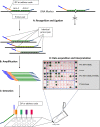Evaluation of a commercial microarray system for detection of SHV-, TEM-, CTX-M-, and KPC-type beta-lactamase genes in Gram-negative isolates
- PMID: 20504993
- PMCID: PMC2897517
- DOI: 10.1128/JCM.00568-10
Evaluation of a commercial microarray system for detection of SHV-, TEM-, CTX-M-, and KPC-type beta-lactamase genes in Gram-negative isolates
Abstract
We evaluated the ability of a commercial microarray system (Check KPC/ESBL; Check-Points Health BV) to detect clinically important class A beta-lactamase genes. A total of 106 Gram-negative strains were tested. The following sensitivity and specificity results were recorded, respectively: for bla(SHV), 98.8% and 100%; for bla(TEM), 100% and 96.4%; and for bla(CTX-M) and bla(KPC), 100% and 100%.
Figures

References
-
- Cornaglia, G., and G. M. Rossolini. 2010. The emerging threat of acquired carbapenemases in Gram-negative bacteria. Clin. Microbiol. Infect. 16:99-101. - PubMed
-
- Endimiani, A., J. M. Depasquale, S. Forero, F. Perez, A. M. Hujer, D. Roberts-Pollack, P. D. Fiorella, N. Pickens, B. Kitchel, A. E. Casiano-Colon, F. C. Tenover, and R. A. Bonomo. 2009. Emergence of blaKPC-containing Klebsiella pneumoniae in a long-term acute care hospital: a new challenge to our healthcare system. J. Antimicrob. Chemother. 64:1102-1110. - PMC - PubMed
-
- Endimiani, A., A. M. Hujer, F. Perez, C. R. Bethel, K. M. Hujer, J. Kroeger, M. Oethinger, D. L. Paterson, M. D. Adams, M. R. Jacobs, D. J. Diekema, G. S. Hall, S. G. Jenkins, L. B. Rice, F. C. Tenover, and R. A. Bonomo. 2009. Characterization of blaKPC-containing Klebsiella pneumoniae isolates detected in different institutions in the eastern USA. J. Antimicrob. Chemother. 63:427-437. - PMC - PubMed
-
- Endimiani, A., F. Luzzaro, R. Migliavacca, E. Mantengoli, A. M. Hujer, K. M. Hujer, L. Pagani, R. A. Bonomo, G. M. Rossolini, and A. Toniolo. 2007. Spread in an Italian hospital of a clonal Acinetobacter baumannii strain producing the TEM-92 extended-spectrum β-lactamase. Antimicrob. Agents Chemother. 51:2211-2214. - PMC - PubMed
Publication types
MeSH terms
Substances
Grants and funding
LinkOut - more resources
Full Text Sources

